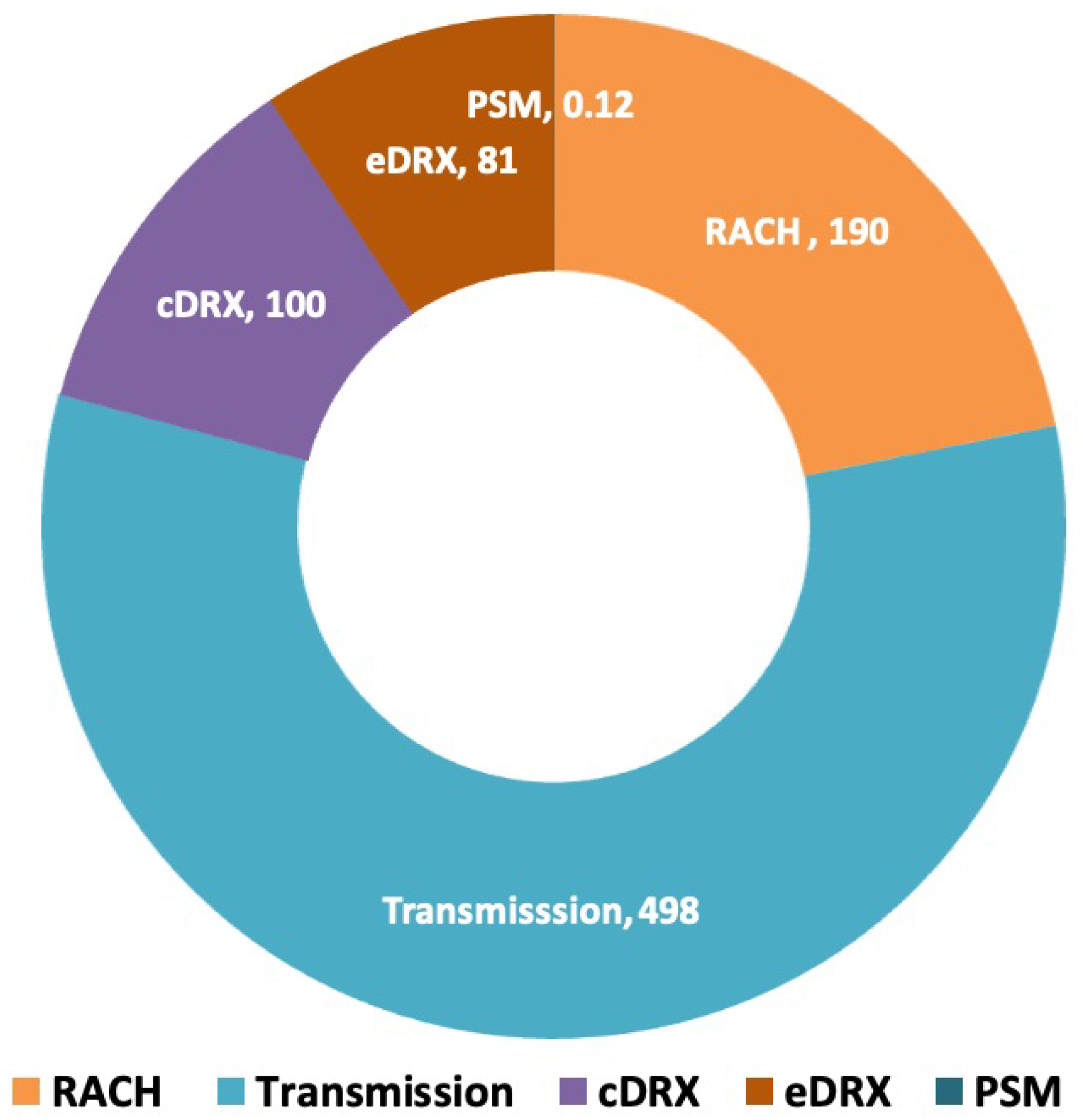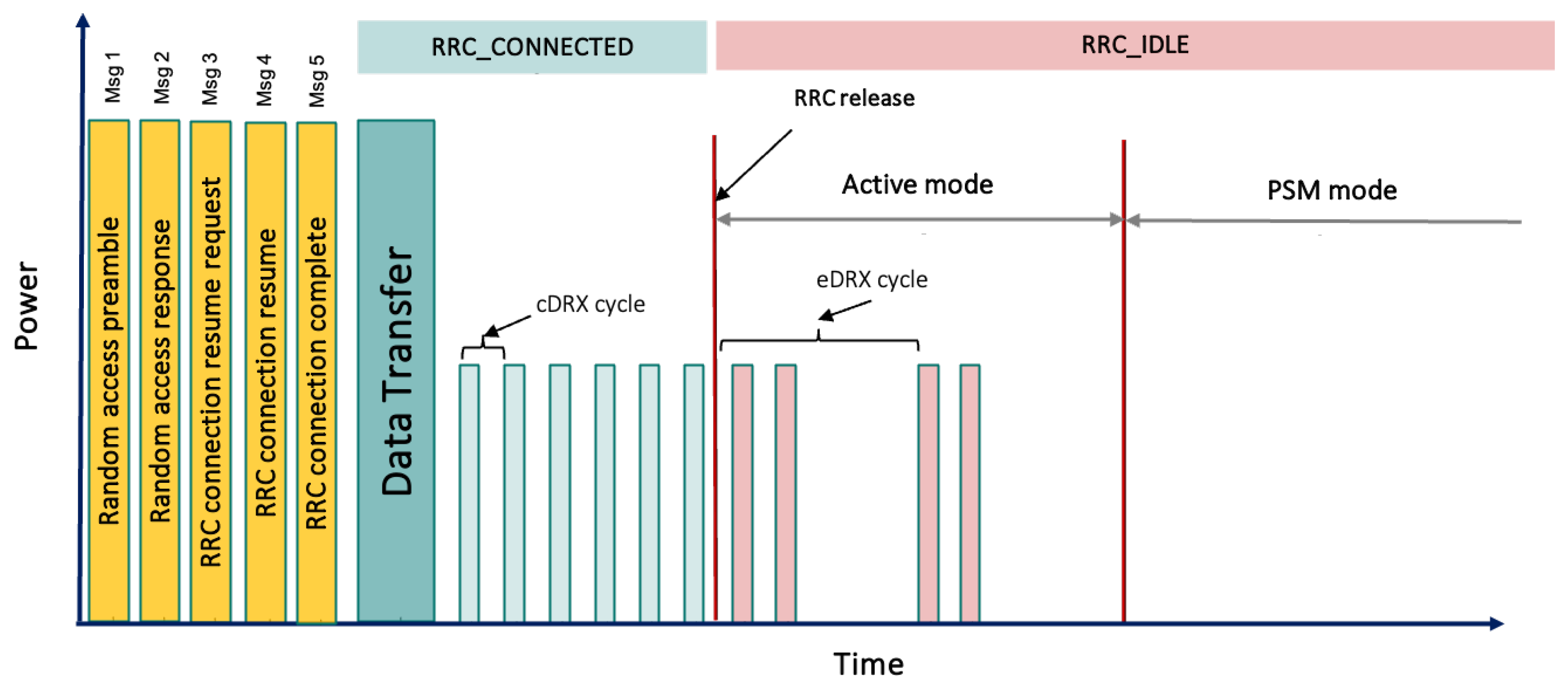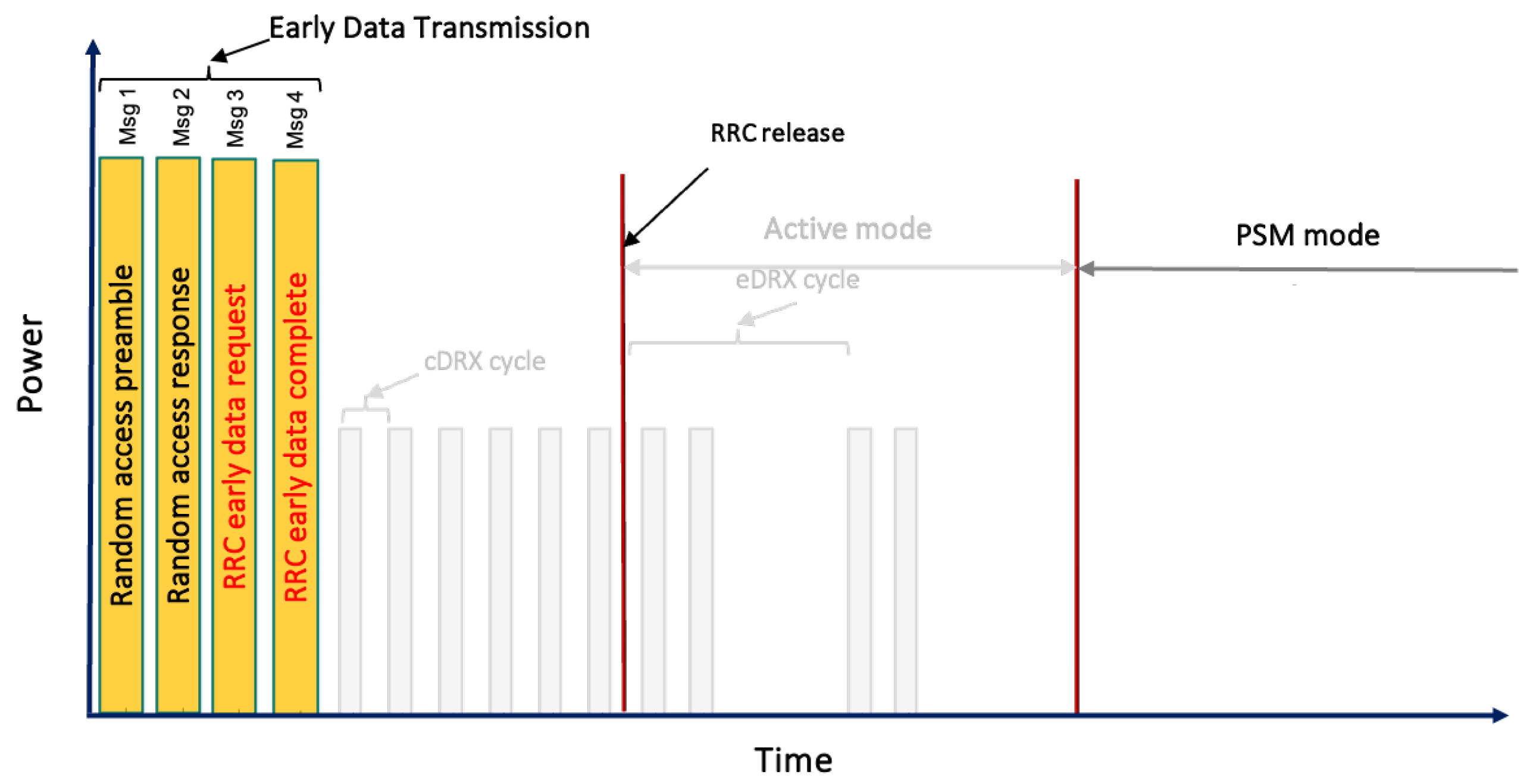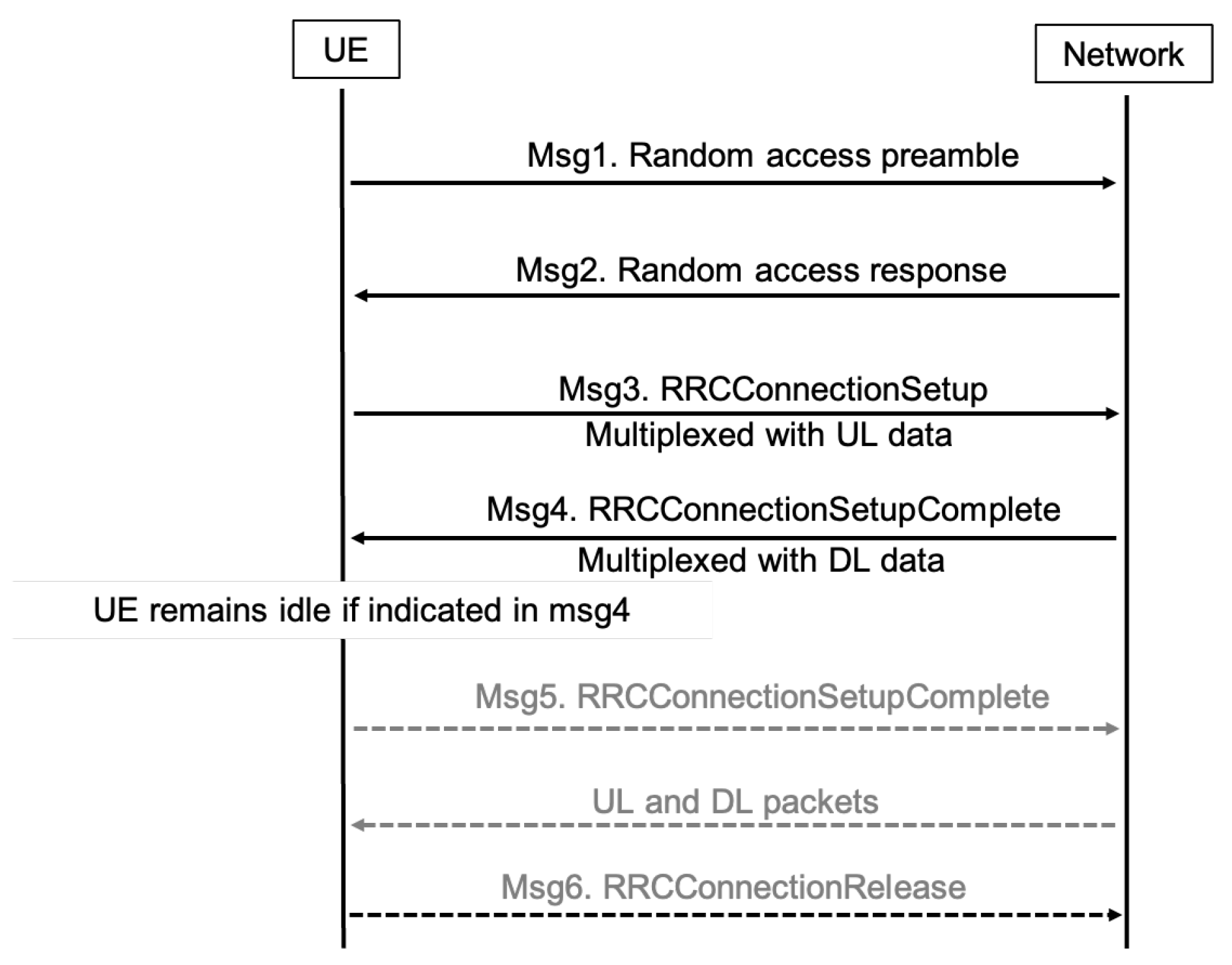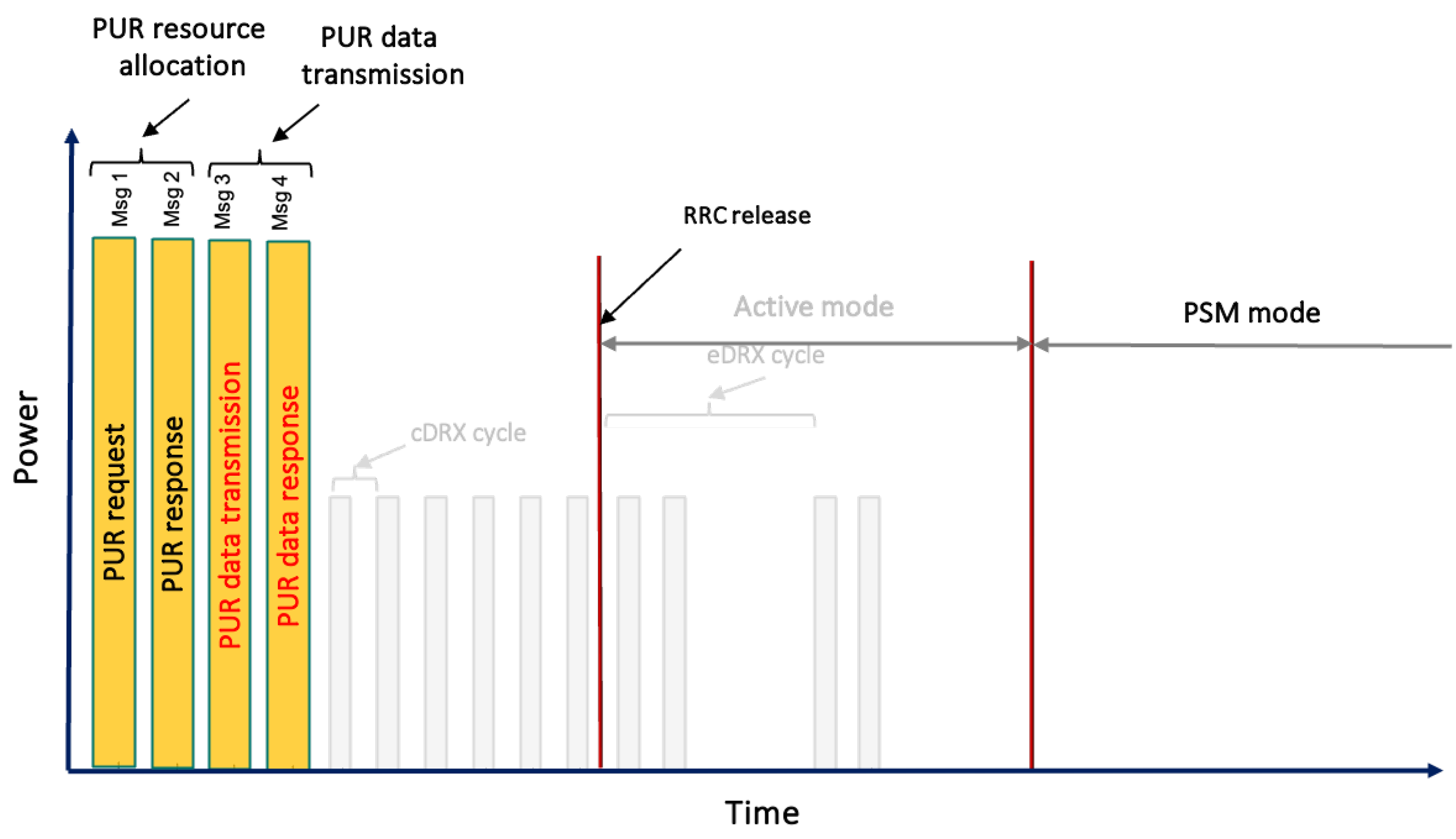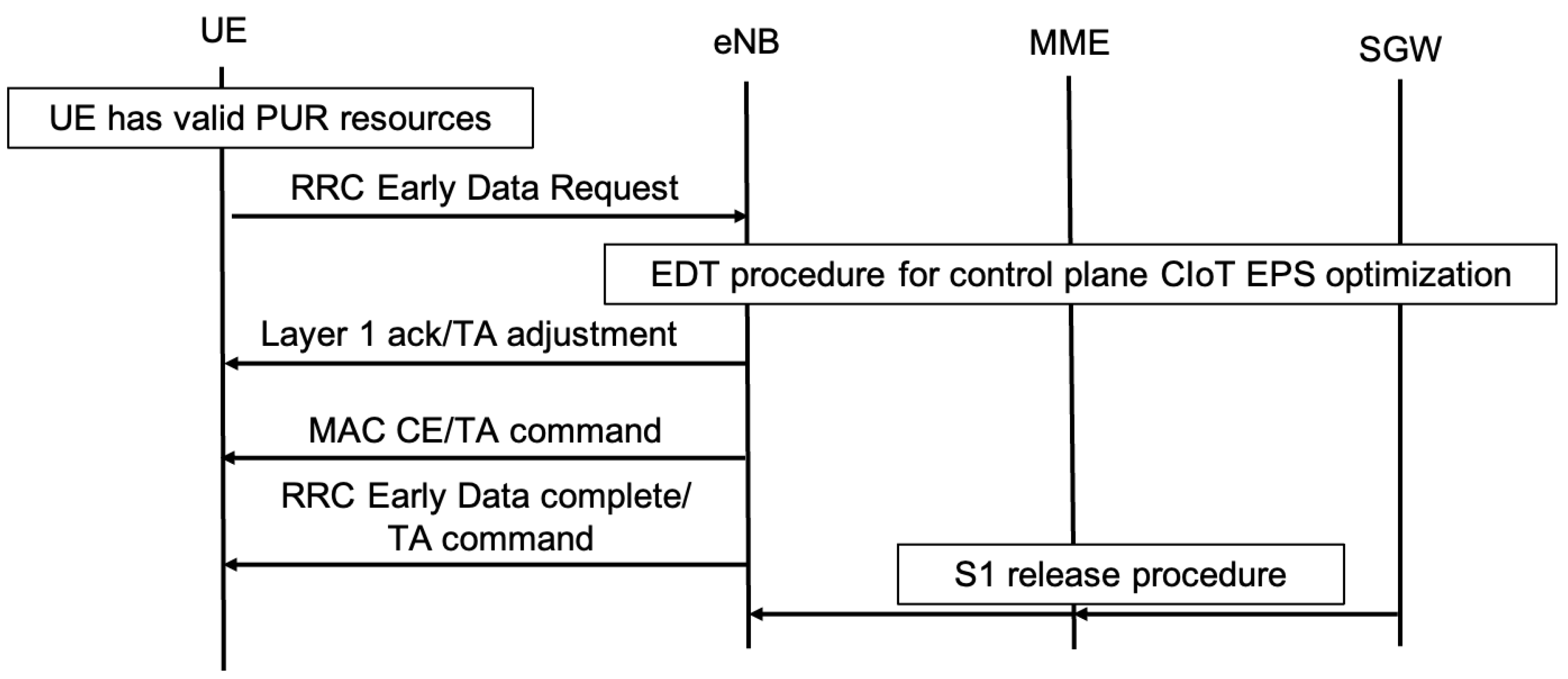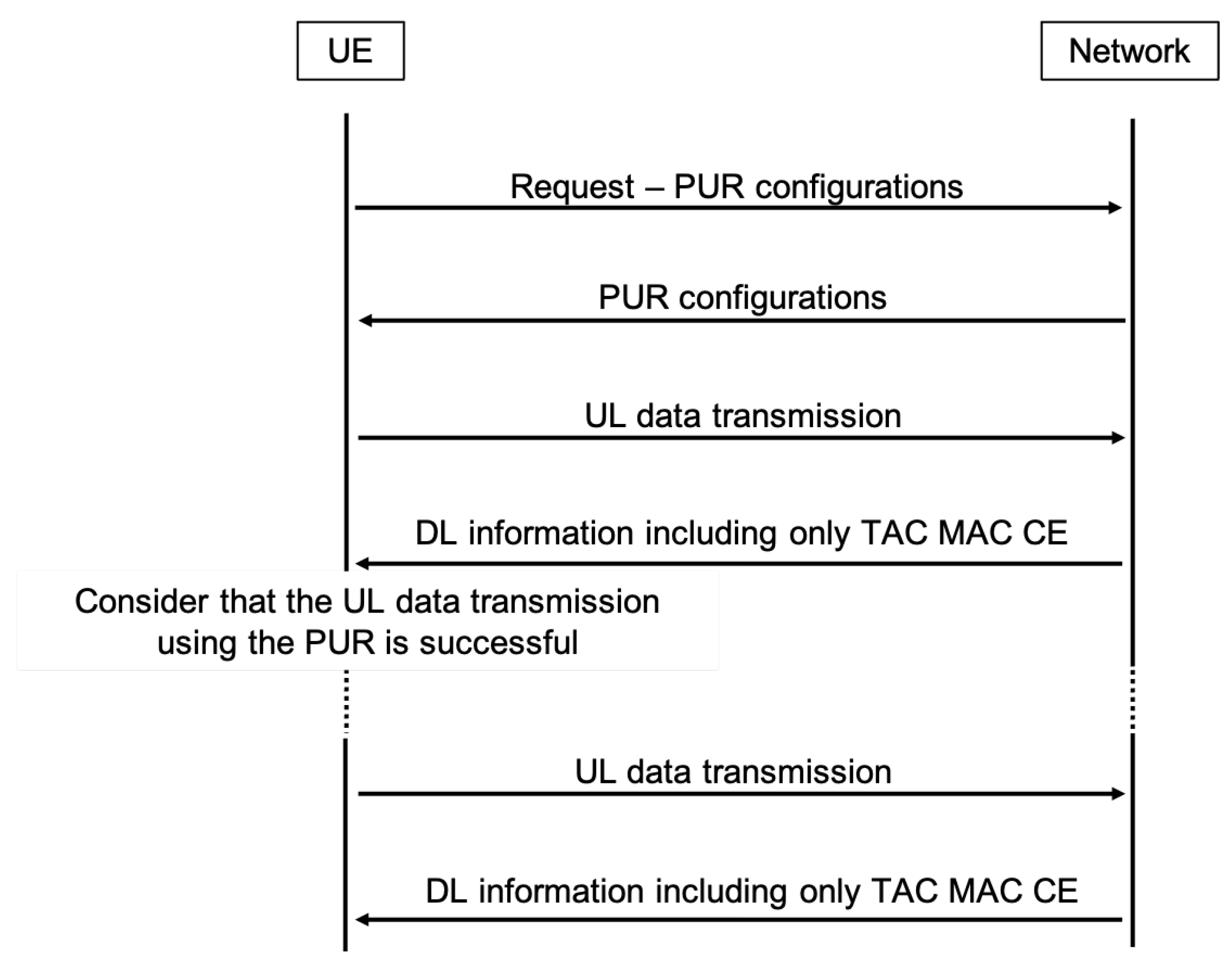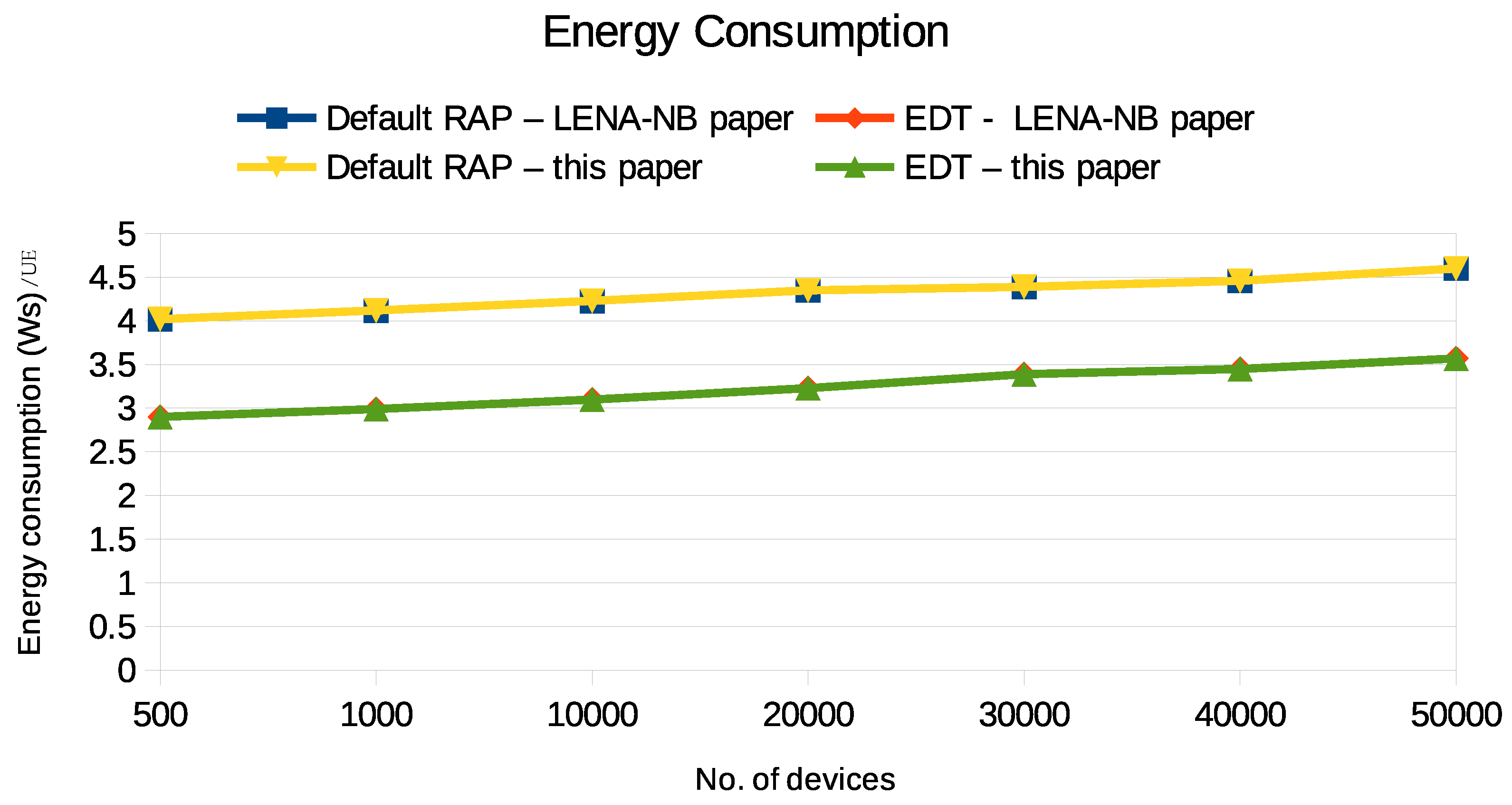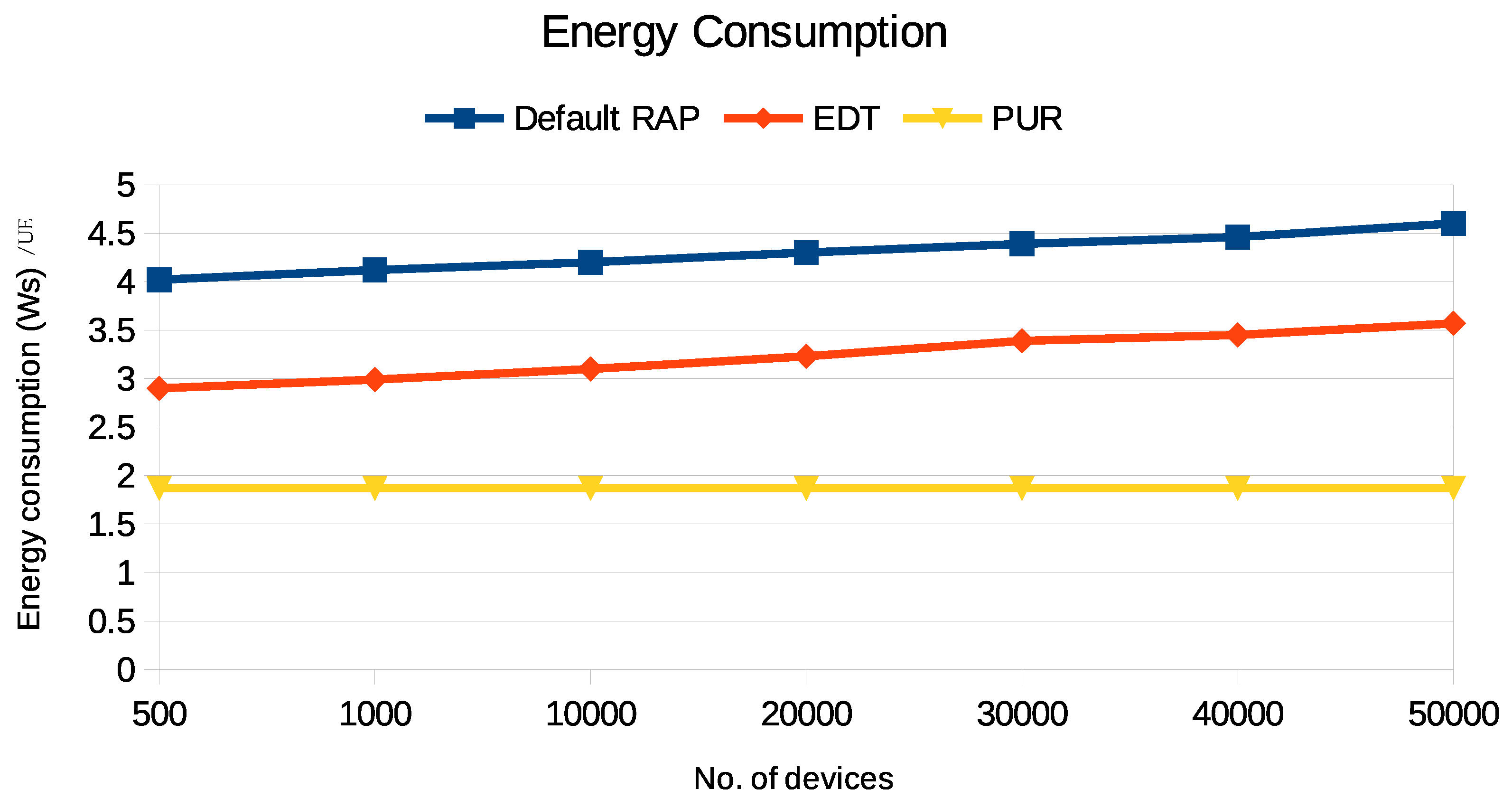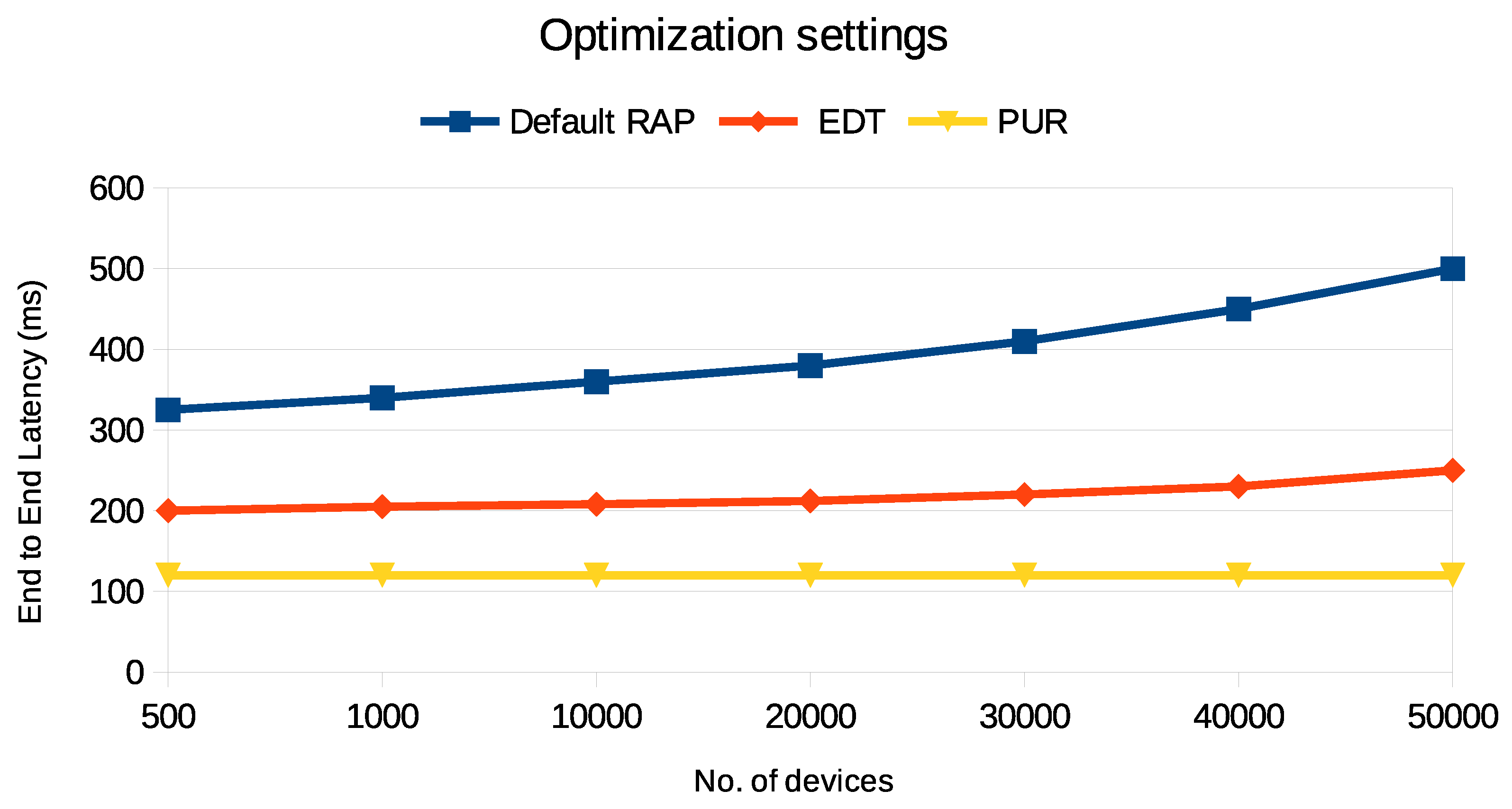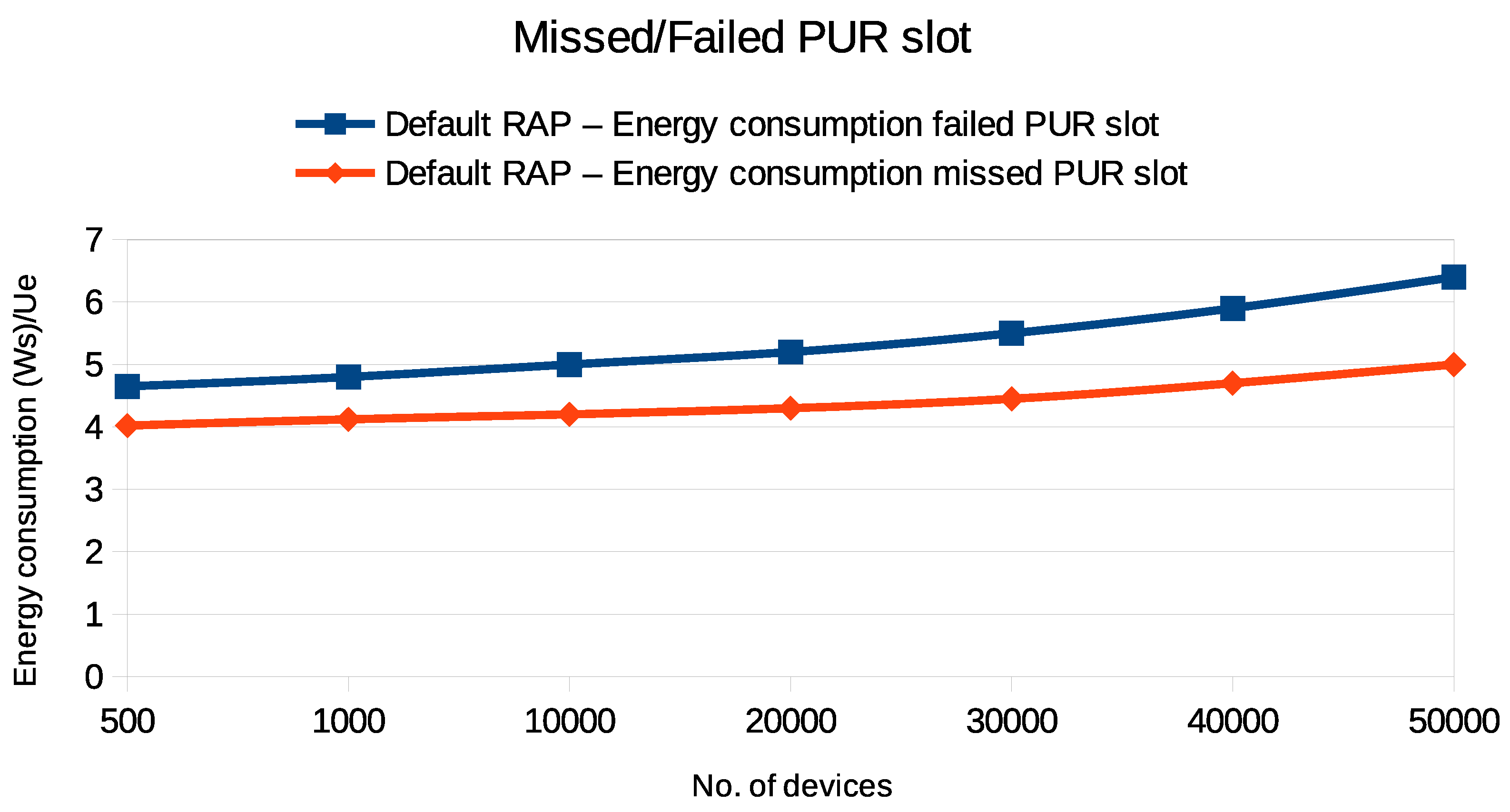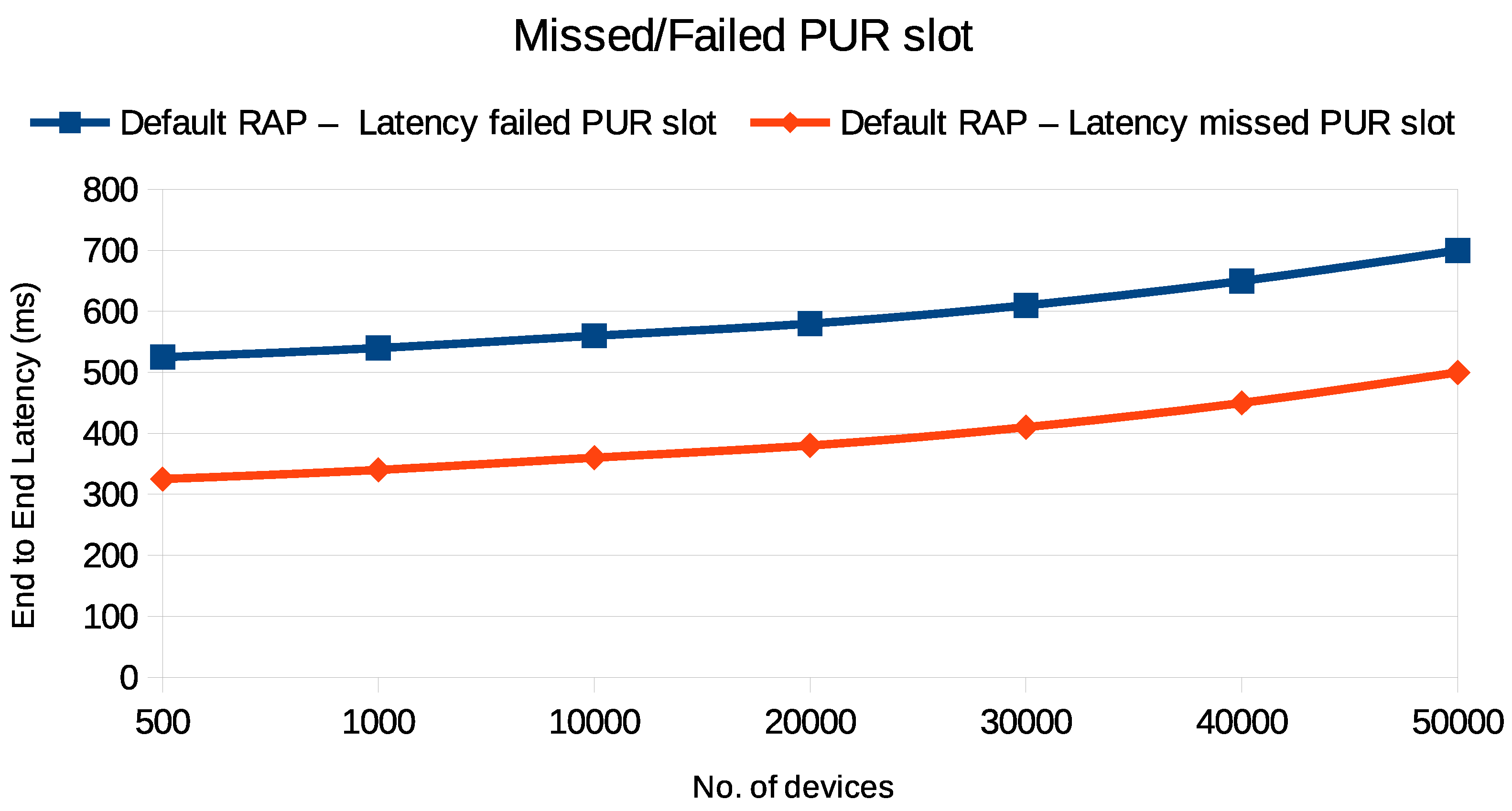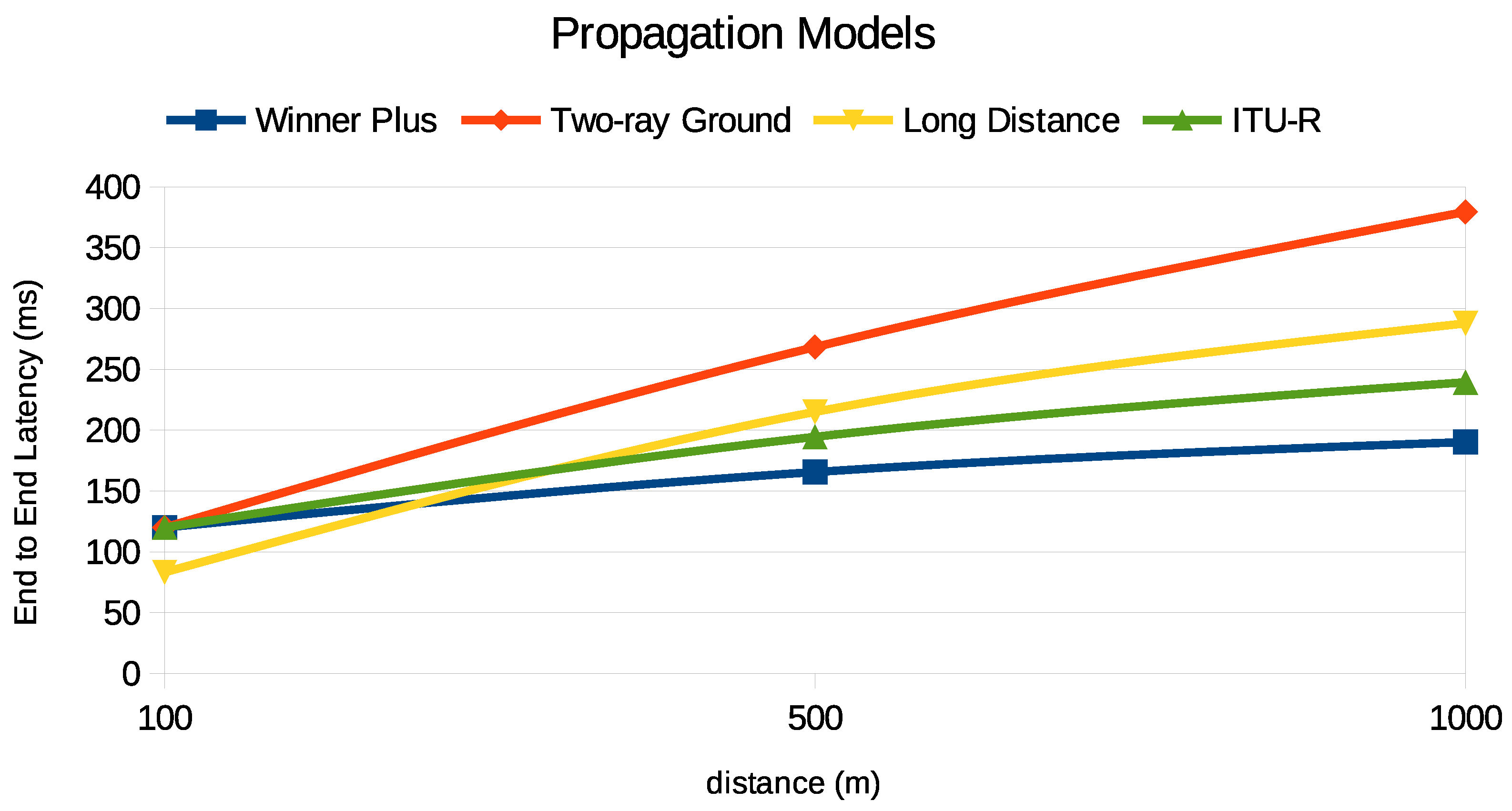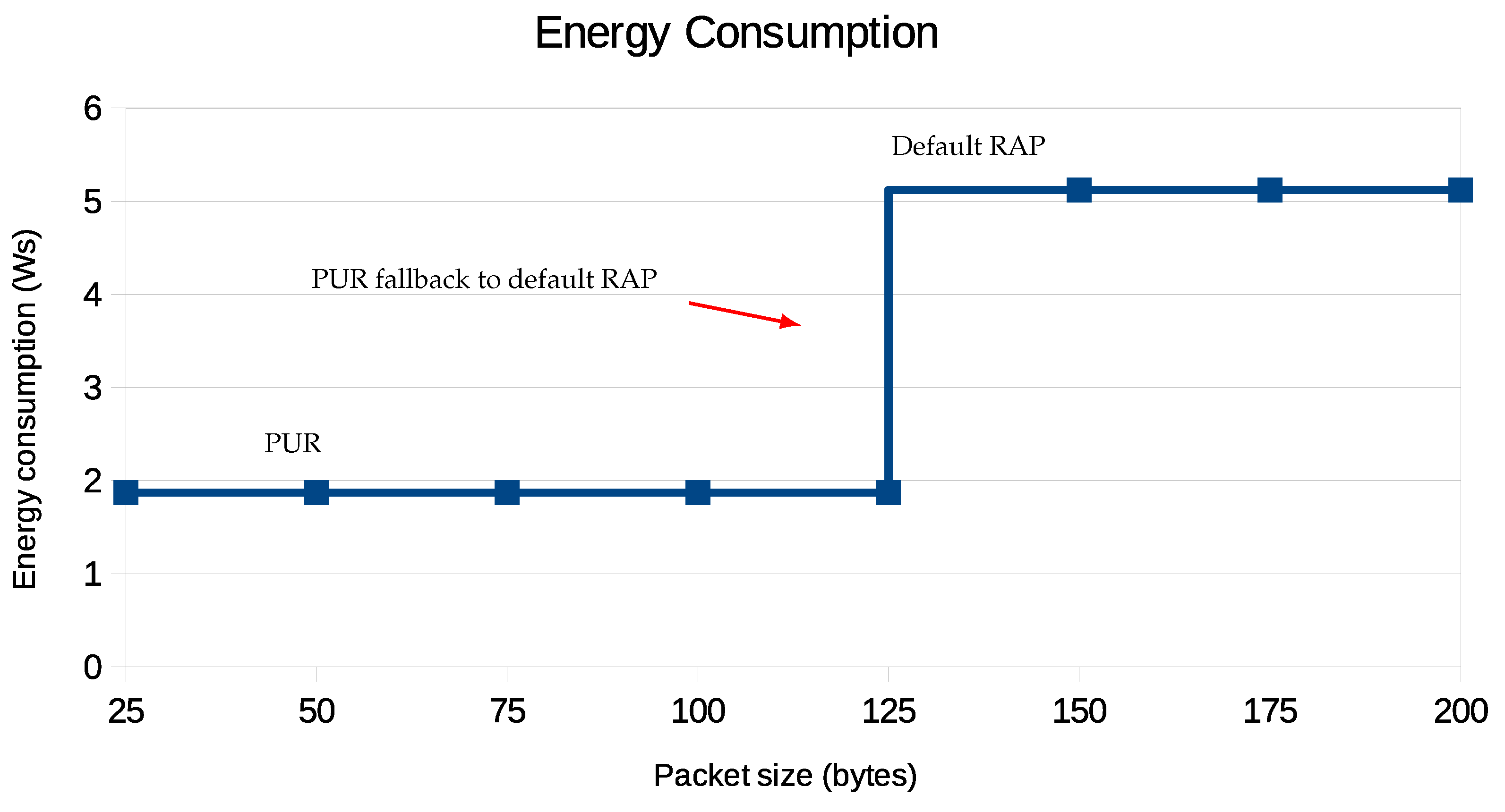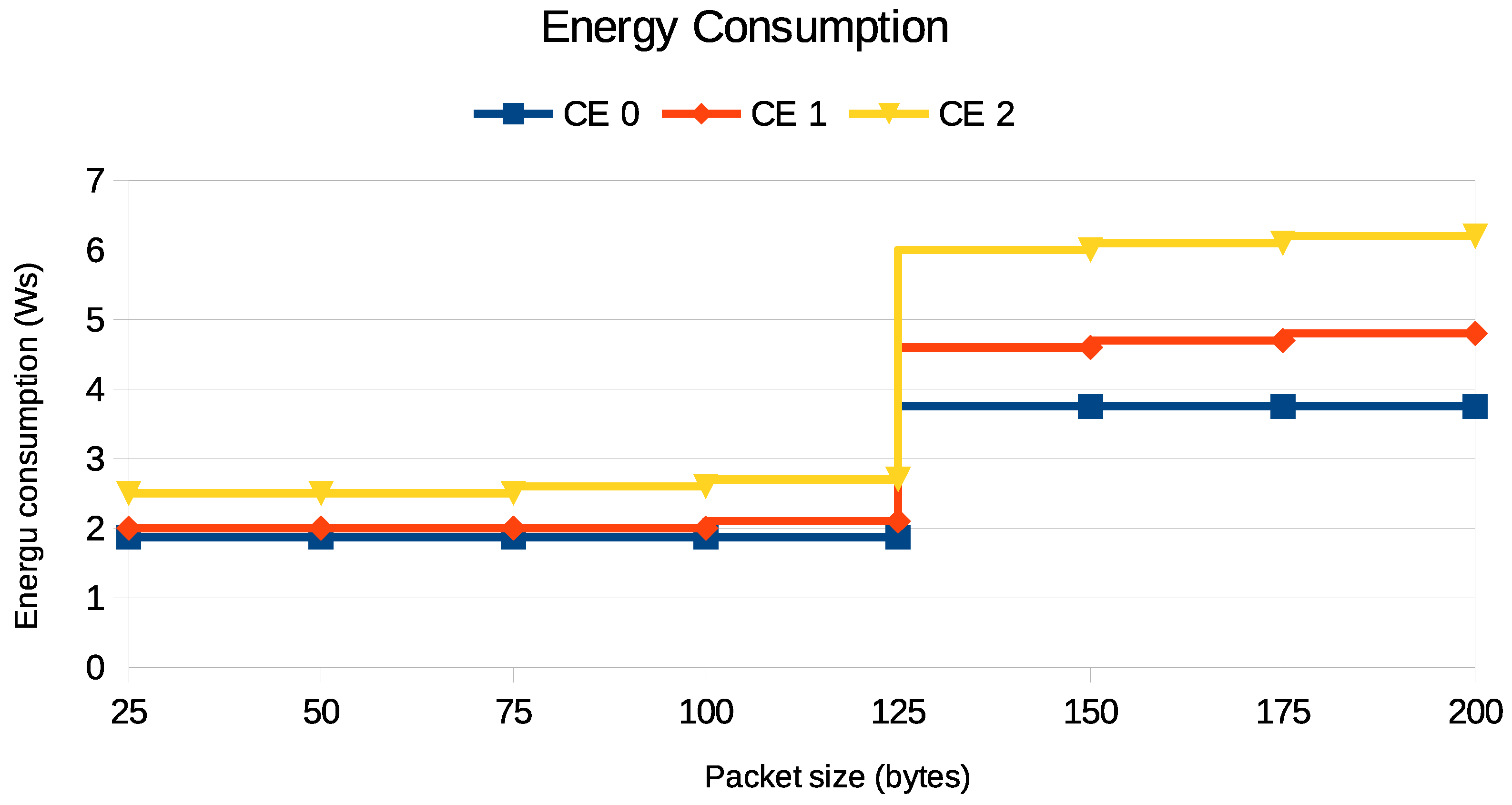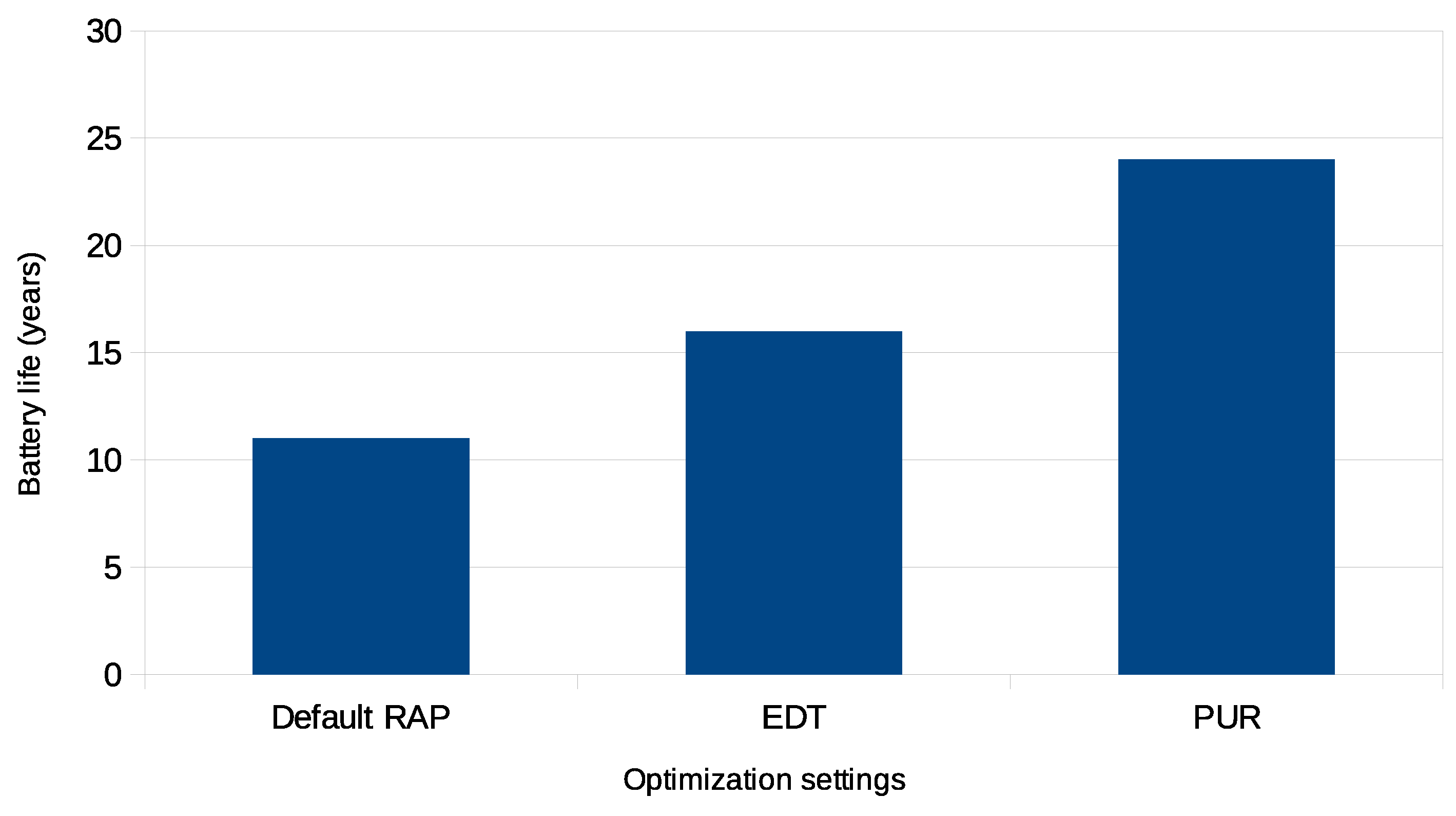1. Introduction
The Cellular Internet of Things (CIoT) is a rapidly evolving field, and the integration of the Narrowband Internet of Things (NB-IoT) has brought a significant transformation to enable efficient and low-power communication across various applications [
1]. NB-IoT is widely used [
2] due to its ability to handle small data packets while sustaining a battery life of up to 10 years. Due to these features, NB-IoT has become an essential element in the world of CIoT connectivity [
3].
Guided by the standards set forth by the 3rd Generation Partnership Project (3GPP) [
4], NB-IoT represents the response to the urgent need for a wireless communication solution tailored to the unique requirements of CIoT devices. These requirements, including extended coverage, minimal power consumption, and cost-effectiveness, have driven the development and standardization of these technologies [
5]. The commitment of 3GPP to establishing a strong, global framework for NB-IoT underscores its significance in the modern connectivity landscape. Whether in smart cities, agriculture, healthcare, or industrial automation, NB-IoT technology has applications in numerous scenarios. The deployment of NB-IoT devices continues to grow, highlighting the crucial need to optimize energy consumption to maintain the scalability and reliability of these networks [
6]. This is particularly important in NB-IoT, where devices often operate in demanding environments with limited power sources.
To address the challenge related to energy consumption, 3GPP, in releases 13 and 14, introduced the Power Saving Mode (PSM), Extended Discontinuous Reception (eDRX), and Release Assistance Indicator (RAI). These strategies effectively balance network connectivity and energy consumption [
7,
8].
In releases 15 and 16, 3GPP introduced two critical mechanisms: Early Data Transmission (EDT) [
9] and Pre-configured Uplink Resources (PUR) [
10] to reduce energy consumption further. EDT involves timely data transmission during the Random Access Procedure (RAP) to minimize energy usage. PUR aims to streamline uplink (UL) transmissions by pre-allocating resources, reducing latency, and ensuring more efficient use of network resources. These strategies contribute to the continued success and sustainability of NB-IoT.
This paper aims to explore the intricacies of NB-IoT energy efficiency. It provides a comprehensive study of EDT and PUR and their impact on energy consumption and latency, offering an in-depth look at the operational mechanisms of NB-IoT. We understand there hasn’t been a detailed and realistic assessment of these optimizations.
In a study by Hoglund
et al. [
10], an analytical model was proposed to evaluate the effectiveness of PUR when sending packets and receiving acknowledgments at different layers. However, analytical modeling has limitations and lacks detail, while simulation offers more realistic and detailed scenarios at the cost of higher computational demands.
To address the analytical limitations, we utilized the ns-3 network simulator to extend LENA-NB [
11] and create a realistic environment for studying the behavior of EDT and PUR under various scenarios, including energy consumption, latency, impact of radio propagation models, PUR missed/failed slot, coverage levels, etc. The main contributions of this paper are summarized as follows.
An implementation of PUR inside LENA-NB.
A study of PUR on energy efficiency, latency, and scalability from a user and network perspective.
A comparative study of PUR with EDT and default RAP, including energy-saving mechanisms. Since our study is conducted within a simulator environment, we argue that they are more accurate than the ones obtained by Hoglund
et al. [
10].
Our study is motivated by the fact that a significant portion of energy consumption in NB-IoT occurs during radio connectivity. This is supported by various studies, including those by Abbas
et al. [
12], Lukic
et al. [
13], and Michelinakis
et al. [
14].
Figure 1 illustrates the energy consumption of an NB-IoT device during its various operational states. It is important to note that a device, throughout its lifespan, circulates through only these operational states. As shown in
Figure 1, the initial connection setup, also known as Random Access Channel (RACH) procedure (orange), packet transmission (light blue), listening to a radio channel (purple), receiving downlink traffic (red) accounts for almost all energy consumption. In contrast, the energy spent in PSM mode (dark blue) is negligible and not visible in the figure. Therefore, the opportunity to find energy savings is in the different active radio states and investigate mechanisms such as EDT and PUR.
The rest of the paper is organized as follows: Section II provides a detailed discussion of NB-IoT technology, operating states, and energy-saving mechanisms. Section III briefly describes our LENA-NB experimental setup in ns-3. Section IV provides a detailed analysis of NB-IoT energy-saving mechanisms. Section V overviews previously published work on EDT and PUR, while Section VI concludes the paper.
2. NB-IoT
NB-IoT technology is an evolution that builds upon Long-Term Evolution (LTE), a widely adopted standard for high-speed wireless communication, as shown in
Figure 2. Collaborative efforts led by 3GPP have resulted in the development of NB-IoT, which specifically addresses the demands of CIoT. NB-IoT operates on narrow bandwidths, optimizing spectral efficiency and facilitating seamless integration into existing LTE infrastructure. It uses licensed spectrum frequencies, typically in the sub-GHz range, ensuring reliable and secure communication over long distances of
km. This inheritance from LTE provides a solid technological base and allows efficient co-existence with other LTE services.
NB-IoT technology enhances its reach through three distinct Coverage Enhancement (CE) levels – CE Level 0, CE Level 1, and CE Level 2 – to improve connectivity in areas with varying signal strengths. These levels, predetermined by the network, dictate the repetition frequency of downlink and uplink traffic to ensure that User Equipment (UE) in low-coverage zones remain connected. CE Level 0 caters to areas with satisfactory coverage, providing a signal boost of +0 dB. For environments requiring more assistance, CE Level 1 steps in with a boost of up to +10 dB. CE Level 2 targets the most challenging conditions by offering a substantial increase of up to +20 dB and permitting up to 128 message repetitions. This advancement increases the maximum coupling loss (MCL) capacity from 144 dB to 164 dB, improving connectivity in “deep indoor" locations where IoT devices may be placed, such as basements and parking structures, areas traditionally problematic for the penetration of 2G, 3G or 4G (LTE) signals.
NB-IoT technology aims to use energy efficiently, particularly for small data transfers. In release 13, two main methods were introduced to optimize this process. First, the User Plane (UP) optimization, or RRC Suspend/Resume method, simplifies the UEs that switch from IDLE to CONNECTED states. It allows devices to “pause" and later “resume" their connection without redoing the entire setup process, saving time and energy. Second, the Control Plane (CP) optimization, or Data-over-NAS method, sends small user data packets through the control channel and bypasses the usual steps of setting up a data connection, further reducing energy use and simplifying data transmission. Both methods are designed to streamline small data transfers; however, CP is more efficient and less energy-intensive [
15].
2.1. Operational States
In the context of NB-IoT, RRC states play a critical role in managing the communication behavior of UE within the cellular network. NB-IoT RRC states dictate the UE’s operational modes, influencing power consumption, latency, and responsiveness. NB-IoT defines two main RRC states: RRC_CONNECTED and RRC_IDLE, as shown in
Figure 2. The RRC_IDLE state represents the state of minimal activity, where the UE conserves power by only periodically listening for paging signals while waiting for potential downlink (DL) data or network commands. On the other hand, the RRC_CONNECTED state signifies an active communication phase, enabling two-way data exchange between the UE and the network. While in RRC_CONNECTED, the UE is more responsive but also consumes more power since it is in what is denoted as the transmission + cDRX state in
Figure 1.
The energy efficiency of NB-IoT is strongly based on energy-saving mechanisms embedded within the RRC states, defined by 3GPP release 13. Among these mechanisms, the connected discontinuous reception (cDRX), the extended discontinuous reception (eDRX), and the power saving mode (PSM) are crucial for minimizing energy consumption while maintaining connectivity, as shown in
Figure 2. cDRX and eDRX modes strategically manage the UE’s reception cycles, allowing it to periodically wake up to listen for incoming signals while spending the majority of time in a low-power dormant state. These mechanisms balance the trade-off between responsiveness and power efficiency. However, PSM is designed mainly for applications with infrequent communication needs. It allows the UE to detach from the network and enter an extended sleep mode, significantly conserving energy. The UE re-establishes communication upon awakening, effectively reducing the network signaling overhead. These energy-saving mechanisms are integrated into NB-IoT’s RRC states, contributing to the technology’s ability to support diverse IoT applications with varying energy constraints.
Based on these improvements, subsequent 3GPP releases, such as 15 and 16 focused on mitigating signaling overhead and power consumption through innovative solutions such as UE-based EDT and PUR. These solutions include CP and UP CIoT Evolved Packet System (EPS) enhancements. Unlike the conventional 5-step default RAP illustrated in
Figure 2, the EDT approach introduces a different method. In this approach, the UE signals its intention to transmit small data during Msg 3. On the other hand, PUR further streamlines the process by enabling direct transmission in Msg 3, without the need for Msg 1 and Msg 2. These innovations mark significant strides in optimizing the NB-IoT handling of small data exchanges and are discussed in more detail below.
2.1.1. Early Data Transmission
To improve the power efficiency of the UE, particularly those that require infrequent small data transmissions in the UL, EDT has been introduced in the 3GPP release 15 [
11,
16]. This approach reduces the power consumption for UEs sending sporadic small data packets by enabling data transmission during RAPs. EDT applies to UP and CP solutions, with differences elaborated later in this section.
To implement EDT, UEs need to signal their intent to engage in data transmission during Msg 3. Compared to release 13, where the eNodeB lacked prior knowledge of the intentions of the UE data transmission, the EDT mandates using a specific (N)PRACH preamble dedicated to the EDT signaled in Msg,1. Furthermore, the network disseminates the maximum Transport Block Size (TBS) that Msg 3 in EDT can utilize. Over-the-air security poses another consideration. In release 13, data bearer security is established after RAP completion, but for EDT, security must be established during Msg 3 transmission. Mechanisms to achieve this are detailed subsequently. In the RRC_IDLE state, if a UE does not have more data than the broadcast maximum, it may employ EDT, as shown in
Figure 3 and
Figure 4.
In the UP solution for EDT within release 15, the UE Application Specific (AS) context facilitates data resumption and signals radio bearers and security context for user plane data transmission. Compared to default RAP, where these procedures took place after Msg 4 reception, the UP solution for EDT entails the UE activating suspended data bearers for Msg 3 transmissions, resuming security, and allowing early DL data transmission.
The CP solution for EDT allows UL data within the initial NAS message "CONTROL PLANE SERVICE REQUEST," transmitted via the RRCConnectionSetupComplete. The objective is to reduce signaling overhead, latency, and UE power consumption. In the CP EDT mechanism, Msg 3 and Msg 4 accommodate NAS messages containing UL and DL user data, ensuring data delivery before Msg 5 while keeping the UE in RRC_IDLE mode.
However, the CP EDT mechanism faces challenges. Unlike the UP EDT approach, it lacks AS security. It employs NAS messages piggybacked on RRC messages through an SRB0 (Signaling Radio Bearer), which can cause issues, especially for Msg 4 with DL data, potentially leading to UEs transitioning to RRC_IDLE mode without guaranteeing successful DL data delivery.
In summary, EDT reduces the need to enter the connected state and, therefore, improves the power efficiency of the UE for small, infrequent data transmissions. The UP and CP solutions differ in handling data transmission during RAPs, with considerations for security and UE state transitions.
2.1.2. Preconfigured uplink resources
The objective of employing PUR is to further enhance the efficiency of signaling, a goal distinct from the approach of EDT [
17]. The initial phase comprises Msg 1 and Msg 2, which initialize contact with the eNodeB and equip the UE with a valid Timing Advance (TA) for UL synchronization. It’s important to note that the initial phase only needs to be completed once, until the UE moves into the proximity of a different eNodeB or the timer for the resources assigned to the UE expires. Subsequently, Msg 3 facilitates the first scheduled UL transmission, housing both an RRC message and a UL data payload. Ultimately, Msg,4 functions to acknowledge UL data transmission, address contention, potentially convey DL data payloads, and orchestrate UE transitions to the CONNECTED state, as shown in
Figure 5. It is important to note that PUR achieves its full potential when the User Equipment remains stationary. However, if the UE moves from the proximity of one eNodeB to another, it must acquire new resources each time it needs to transmit a packet. This process is no different from the mechanism used by EDT.
The strategy behind pre-configuring the UE with UL radio resources, under the assumption of a valid TA, is to eliminate the necessity for Msg 1, Msg 2, and conventional connection establishment procedures. Activation of PUR involves dedicated RRC signaling while the UE is in CONNECTED state, encompassing the acquisition of UE-specific radio resources and a Radio Network Temporary Identifier (PUR C-RNTI), among other parameters.
A comprehensive PUR configuration incorporates periodic time-frequency resources, Modulation and Coding Scheme (MCS), Transport Block Size (TBS), PUSCH (Physical Uplink Shared Channel) repetitions, Demodulation Reference Signal (DMRS) configurations, power control parameters. Triggers for UE configuration with PUR include transmitting a PUR Configuration Request message by the UE to an eNB while in an RRC_CONNECTED state or network-driven activation based on subscription data or identified periodic traffic patterns.
Before executing a PUR transmission, the UE evaluates the validity of the TA through individual or combined attributes evaluation, which includes whether the serving cell has changed, the expiration of the PUR TA timer, and variations in received signal power (RSRP). Successful receipt of UL PUR transmissions by the eNB can lead to the conclusion of the PUR procedure in only two messages: UL and DL, recognized through layer-1 signaling in DL Control Information (DCI) or layer-2/3 signaling in an RRC message.
The adaptable periodicity of PUR resources reflects their suitability for periodic traffic scenarios. However, the configuration flexibility allows the UE to skip transmitting for several consecutive PUR occasions before automatic configuration release.
Unlike EDT, successful reception of UL PUR transmissions can sometimes be adequately acknowledged through layer-1 signaling if there are no pending DL data. Such acknowledgments might include adjustments to TA, the number of PUSCH repetitions, or even an indication to employ EDT or the ordinary connection establishment procedure. In alternative scenarios, responses to UL PUR transmissions might be conveyed via layer-2/3 signaling (RRC messages) not only for acknowledgments but also for downstream user data transmission, PUR configuration adjustments, and potential UE state transitions.
Two distinct schemes exist for PUR transmissions: dedicated PUR and shared PUR. In the former, UL time-frequency resources are exclusively allocated to a single UE at any given time, particularly suitable for UEs transmitting periodically in the UL. Shared PUR allows concurrent use of the same UL resources by up to two UEs, distinguished through orthogonal demodulation reference signal sequences. This approach accommodates both periodic and pseudo-varying traffic patterns. However, to prevent excessive interference, shared PUR’s effectiveness is limited to low Signal to Interference and Noise Ratio (SINR) regimes.
A cap on the number of UEs employing shared PUR is implemented to manage the potential risk of DL congestion, as simultaneous DL transmissions cannot overlap. The shared PUR additionally requires the assignment of distinct PUR C-RNTIs for each of the two UEs transmitting simultaneously. In contrast, dedicated PUR allows using a single PUR C-RNTI by multiple UEs, as their use of resources occurs at different points in time. PUR employs a single Hybrid Automatic Repeat reQuest (HARQ) [
18] process and can be combined with other features to enhance performance.
3. Simulation environment
The main reason for conducting a simulation study is that while it is clear from the standardization process that EDT and PUR can help reduce energy consumption and improve latency, there is currently no implementation of EDT or PUR by network operators, and no end devices support them. Based on our experience, network operators and end devices currently support Release 13 and 14 features. LENA-NB [
11] offers a simulation framework with a detailed implementation of radio access technology for NB-IoT, including control plane optimization [
3] and EDT. Furthermore, LENA-NB includes several NB-IoT features to enhance network efficiency and reduce device costs. These features include:
A connection resume procedure: An important aspect of LENA-NB is implementing the connection resume procedure, part of the RRC connection setup procedure. This functionality lets devices quickly reconnect to the network without redoing the entire setup process. The implementation begins with the device receiving a unique resume ID during the RRC Connection Release phase, crucial for reinitiating a connection without a full setup. A data inactivity timer monitors transmission inactivity, triggering the Connection Release procedure when necessary. This process not only saves the specific entities of the device to the resume ID but also ensures efficient resource management by releasing the C-RNTI and cleaning up pending events. Upon attempting reconnection, the device uses the saved resume ID to restore its connection state, significantly reducing the time and resources required for network re-entry.
Cross-subframe scheduling: Recognizing the absence of an NB-IoT-specific error model, LENA-NB employs a pragmatic approach using a lookup table derived from MATLAB NB-IoT Block Error Rate (BLER) simulations. This table assists in selecting optimal uplink and downlink configurations that meet BLER standards under various channel conditions, optimizing the simulator’s performance across a wide range of scenarios.
A NB-IoT-specific energy state machine: To provide a detailed simulation of power efficiency, LENA-NB implements the eDRX and PSM techniques at the RRC level. The simulator incorporates an energy state machine that monitors the energy states of a device across different operations, including sending and receiving on various channels and modes, e.g., NPRACH, NPDCCH, NPDSCH, and NPUSCH. This state machine is critical in analyzing and optimizing energy use, drawing on real-world power consumption data (Quectel BG95 NB-IoT/eMTC module [
19]) to provide an accurate and comprehensive energy consumption analysis.
These implementations and modifications are designed to provide a comprehensive understanding and evaluation of UE performance and efficiency in various operational scenarios.
In our experiments, the simulator is extended with the implementation of PUR [
20], as shown in
Figure 6. This addition allows a UE to request specific radio resources, such as packet intervals, TBS, and offset. This request is sent by UE RRC (
) to eNodeB RRC (
) before starting transmission, as shown in
Figure 7. PUR is designed to handle a maximum packet size of 125 bytes. Packets larger than this limit must be segmented for transmission via PUR; otherwise, the system reverts to the default RAP for managing larger packets. Upon receiving a resource request, the
passes it to the eNodeB MAC layer (
), which then forwards it to the scheduler. The scheduler reserves all PUR-specific resources in the UL grid to ensure these are not allocated to other transmissions. The scheduler then communicates the scheduling information and the assigned resources to
. It is worth mentioning that resource allocation is predetermined offline before the simulation begins. This pre-allocation is necessary because the eNodeB assigns resources to a UE for a fixed duration, determined by a timer. However, the timing of packet transmissions by the UE, based on the assigned PUR resources, is adjustable. Once a UE has valid PUR resources, it can transmit data directly to eNodeB.
In addition, it is worth mentioning that setting up a UE with PUR can be done in two ways. First, the UE can initiate the process by sending a PUR request to an eNodeB. Alternatively, the network can trigger the configuration based on factors like subscription details or recognition of a regular traffic pattern. In our simulations, we have only considered the PUR triggered by a UE, as shown in
Figure 8.
4. Experiments
In evaluating PUR’s functionality, we conducted a series of experiments focusing on different parameters.
Table 1 outlines the parameters affecting the behavior of the UE at various CE levels, while
Table 2 lists the parameters relevant to our simulation setup. The UEs were divided equally among three coverage conditions: outdoors, indoors, and "deep indoor" environments such as basements.
In the default RAP, a UE sends one message per day and enters an IDLE state after a 20-second wait in connected mode. For EDT and PUR, a UE moves into the IDLE state immediately after sending an uplink packet and receiving the corresponding acknowledgment. The radio signal is weaker for "indoor" and "deep indoor" placements, requiring more repetitions for the same message, as shown in
Table 1, columns CE1 and CE2. The path loss of the UE is calculated using the Winner+ channel model, which simulates both line-of-sight (LOS) and non-LOS propagation conditions. Additionally, the configurations include building losses of 15.4 dB for "indoor" and 20.9 dB for "deep indoor," as derived from [
21].
Our simulations last 45 minutes, but we concentrate our evaluation on a central 15-minute interval. The initial 15-minute period usually produces little results because UEs are scheduled in an empty cell, resulting in excellent transmission conditions. However, after this period, the ongoing transmissions from the earlier UEs create a more realistic environment and yield significant results. To account for transmissions initiated but not completed within this time frame, we simulate an additional 15 minutes, introducing new transmissions to maintain channel activity and allowing earlier UEs to complete their transmissions. However, this does not apply to PUR since eNB allocates resources beforehand, reducing the dependence on interference from other UEs.
Initially, we validated the LENA-NB simulator extended with PUR against the original LENA-NB simulator [
11]. The results from this validation are depicted in
Figure 9. We conducted a comprehensive comparison, which included generating results for 50,000 UEs to evaluate energy consumption. The results indicated that the energy consumption levels of EDT and the default RAP in our experiment were very similar to those found in [
11]. After validating our simulation setup, our research primarily delves into PUR – an area that we consider crucial for understanding energy efficiency in the NB-IoT. Therefore, in the following sections, we will delve deeper into the analysis of PUR, emphasizing its significance and potential impacts on network performance.
4.1. Scalability
The introduction of PUR significantly improves the network scalability in NB-IoT by allowing more devices to connect compared to the default RAP and EDT. This mechanism is particularly effective for managing uplink communication from multiple IoT devices. By pre-allocating uplink resources, PUR enables UE to transmit data without dynamic resource scheduling, which can be complex and resource-intensive, especially in large-scale deployments. In addition, the simulations showcase eNB’s capability to serve up to 62,000 UEs under idealized radio conditions in an idle environment within one day. Additionally, a dedicated PUR setup with a 10% PUSCH BLER can manage up to 52,000 UEs.
4.2. Energy Consumption and Latency
The graphs in
Figure 10 show the energy consumption of default RAP, EDT, and PUR. Both default RAP and EDT show a linear increase in energy usage as the number of UEs in the network increases. However, EDT is more energy efficient, consuming approximately 3.5 Ws per UE for 500 UEs and slightly above 4 Ws per UE for 50,000 UEs. PUR optimization exhibits the lowest energy consumption at 2.5 Ws per UE. It optimizes the scheduling of uplink transmissions and enhances control channel resource allocation. The linear energy consumption observed in default RAP and EDT is attributed to the random intervals at which packets are transmitted, causing devices to wait for ongoing transmissions to complete. In contrast, EDT’s constant energy consumption line is due to the pre-assigned time and frequency resources, eliminating the need for competition. Moreover, the linear energy consumption observed in RAP and EDT, causing devices to wait for ongoing transmissions to complete, is due to the random time intervals at which packets are transmitted. In contrast, the constant energy consumption line for PUR is due to the pre-assigned time and frequency resources, eliminating the need for competition.
Figure 11 presents the end-to-end latency performance in NB-IoT networks under the two optimization settings, EDT and PUR. EDT and PUR demonstrate improved latency over default RAP, particularly when more UEs are served, but their mechanisms differ significantly. EDT involves multiple communication steps between the UE and the network, completing the transmission of the packet in four messages. On the other hand, PUR only uses two messages to complete communication, assigning radio resources to UEs beforehand, reducing the time and complexity involved in the communication process. Thus, PUR minimizes latency and reduces the rate at which latency increases with the addition of more UEs, making it a crucial optimization technique for large-scale IoT deployments.
The graphs in
Figure 12 and
Figure 13 demonstrate the impact of missed or failed PUR slot transmissions on energy consumption and end-to-end latency in UE.
Figure 12 illustrates two scenarios: one where the UE reverts to the default RAP after a failed PUR attempt and another where the UE misses the PUR slot and falls back to the default RAP. It is evident that the failed PUR attempt and the fallback to the default RAP result in significantly higher energy consumption compared to the missed PUR slot. Similarly,
Figure 13 reveals that the latency is greater when the UE switches to the default RAP following a failed PUR attempt, compared to the scenario in which the PUR misses the slot. Both figures indicate that energy consumption and end-to-end latency increase as the number of devices increases, highlighting the inefficiency of a failed PUR transmission. This increased energy consumption and latency is due to the additional energy used during the failed PUR attempt and the subsequent less efficient default RAP transmission, leading to delays in resource acquisition and overall system inefficiency.
4.3. Propagation Models
We are examining how various propagation models affect the performance of PUR. We particularly focus on energy consumption and end-to-end latency, as illustrated in
Figure 14 and
Figure 15. We are considering four models: Winner Plus [
22], Two-ray Ground [
23], Long Distance Pathloss [
24], and ITU-R [
25]. Each model has distinct characteristics influenced by environmental factors and propagation effects.
The Winner Plus model, commonly used in urban macro-cell environments, shows a moderate increase in energy consumption and latency with distance due to realistic urban propagation effects like shadow fading and multipath reflections. On the other hand, the Two-ray Ground model, which considers both direct and ground-reflected paths, results in significantly higher energy consumption and latency over long distances due to destructive interference and signal loss.
The Long Distance Pathloss model demonstrates a logarithmic increase in the energy consumption and latency, reflecting compounded signal losses and increased power requirements over extended distances. Meanwhile, the ITU-R model, with its power-law path loss relationship, provides a balanced approach with moderate energy consumption and latency increases, making it suitable for various environments.
These findings emphasize the importance of selecting an appropriate propagation model based on specific deployment scenarios to optimize the trade-off between energy efficiency and latency in NB-IoT networks.
4.4. Packet size
NB-IoT is a crucial technology in IoT applications due to its low power consumption. However, the energy efficiency of this technology is significantly influenced by the size of the packet, as shown in
Figure 16 and
Figure 17.
Figure 16 illustrates the energy consumption for two different methods of packet transmission: PUR and default RAP. The PUR method efficiently handles packet sizes up to 125 bytes, maintaining relatively stable energy consumption. However, once the packet size exceeds 125 bytes, the system switches to the default RAP, resulting in a sharp increase in energy consumption. For packet sizes between 125 and 200 bytes, the energy consumption remains high but stable, indicating the less energy-efficient mode of the default RAP.
Figure 17 shows the trade-off between different coverage levels and energy consumption for UEs that uses PUR. When UEs need to cover a wider area, they use more energy, especially when the packet size is larger. This becomes especially noticeable when a UE has to use PUR to send packets larger than 125 bytes, causing the packets to be split and sent in multiple PUR occasions as PUR only supports a maximum packet size of 125 bytes.
When packets exceed 125 bytes, an additional PUR occasion is necessary. This requires another round of transmission and acknowledgment, effectively doubling the energy consumption compared to when the packet size remains at or below the threshold. Despite this, using PUR for packet transmission is still more energy-efficient than the default RAP, especially for CE Levels 0 and 1 as shown in
Figure 16. However, it is important to note that for CE Level 2, PUR’s energy consumption increases. The reason is that a UE with poor coverage ends up sending more repetitions of the same packet in the lower layers, as shown in
Table 1, to increase the probability of successful transmission of the packet. This has implications for the deployment of NB-IoT solutions, as UEs operating in areas that require CE Level 2 will have shorter battery life and may need more frequent battery replacement. This increased energy consumption can be attributed to the higher power requirements for signal transmission and reception and a higher number of repetitions for the same packet at lower layers.
4.5. Expected Battery Life
Figure 18 compares the battery life expectancy of an NB-IoT device under different optimization settings. These simulations involved transmitting 49 bytes of data every 24 hours. After transmission, the UE enters the IDLE state, except in the default RAP scenario, where the UE stays awake until the inactivity timer expires before transitioning to the IDLE state.
The figure illustrates that the default RAP has the shortest battery lifespan due to its conventional method, which involves multiple steps for establishing a network connection. This requires frequent UE wake-ups and consumes significant energy for communication. On the other hand, EDT improves battery life by 1.6 times compared to the default RAP [
11]. EDT achieves this by allowing the UE to send data immediately after the initial access attempt, reducing the need for multiple network interactions. The most significant improvement is observed with PUR, where network resources are allocated in advance. This reduces the need for repetitive access procedures and minimizes the active communication time of the UE, resulting in a 2.1 times increase in battery life compared to the default RAP. This optimization enables extended battery life, which is crucial for the sustainability of UEs in long-term deployments where frequent battery replacements are not practical.
5. Related work
Extensive research has been conducted on optimizing the overall energy consumption of NB-IoT devices. Adjustable parameters such as cDRX, eDRX, PSM [
8,
12], CP, and UP optimizations [
26,
27] and the default RAP [
13,
14] have been explored. Moreover, there are some previous studies on PUR [
10,
28]; however, these studies mainly rely on theoretical models and analyses. Therefore, additional research is needed to improve our understanding of how PUR impacts NB-IoT energy efficiency.
The authors Jorke
et al. [
11] implemented NB-IoT in the LENA-NB ns-3 framework. In their evaluation of NB-IoT, they showed that EDT could offer up to 2.9 times less latency, 1.6 times longer battery life, and 3.7 times less spectral usage than the standard optimization of the NB-IoT control plane. We heavily rely on their simulation environment as a vital part of our research infrastructure.
Wang
et al. [
29] showed how EDT and PUR could reduce NB-IoT signaling overhead in industrial IoT systems. Hoglund
et al. [
10] showed that PUR is the most effective way to reduce UE power consumption when frequent data transmissions with small payloads are involved. For instance, with a 30-second periodicity, a 50-byte payload, and a 43-minute eDRX cycle, PUR yields gains ranging from 7% in deep coverage to 50% in good coverage compared to EDT. The authors conclude that PUR significantly reduces signaling exchanges for small-size data transmissions, especially when uplink data transmissions occur hourly or less frequently, and the payload is minimal. Hoglund
et al. also compare two PUR transmission schemes, dedicated and shared PUR. Their research shows that shared PUR provides a 100% increase in the utilization of PUSCH resources in low SINR regimes, while dedicated PUR is more versatile across SINR regimes, making it the preferred choice in several other scenarios.
Prasad
et al. [
28] introduced SmartPUR, a version of PUR that utilizes Machine Learning (ML) techniques to verify and predict TA for mobile CIoT devices. Their evaluation of SmartPUR demonstrates its capability to significantly minimize fallback rates and reduce power consumption for mobile CIoT devices.
Finally, the paper by Khlass
et al. [
30] examines two methods for transmitting small amounts of data while the device is inactive. The first method uses RACH, and the second uses Configure Grant (CG). The study compares the two methods and examines their impact on packet delay, power consumption, and signaling overhead metrics. The results show that the CG-based method is better, with improved power efficiency and reduced latency.
6. Conclusions
This paper examined the impact of PUR on NB-IoT energy consumption and compared it with EDT and the default RAP mechanism. We tested PUR using the LENA-NB framework in ns-3, and our tests indicated that PUR significantly reduces energy consumption and latency compared to default RAP and EDT. By pre-allocating network resources, PUR reduced latency by 2.5-3.5 times and energy consumption by 2.1 times compared to default RAP, while EDT reduced latency by 1.5-2 times and energy consumption by 1.6 times.
Our research shows that using PUR and EDT can significantly improve the energy efficiency and overall performance of NB-IoT networks. Based on our simulation results, we strongly recommend that these optimization techniques be widely adopted in future IoT deployments to create more sustainable and efficient CIoT networks. However, we still need to verify our findings in real-world deployments, which we plan to do once EDT and PUR are supported in commercial cellular networks. Additionally, we aim to explore the limitations and possibilities of using PUR for large-scale deployments. It will be crucial to assess the scalability of shared and dedicated PUR, and we plan to address this in our future work.
References
- Hassan, M.B.; Ali, E.S.; Mokhtar, R.A.; Saeed, R.A.; Chaudhari, B.S. NB-IoT: Concepts, applications, and eployment challenges. In LPWAN Technologies for IoT and M2M Applications; Elsevier, 2020; pp. 119–144.
- Lin, Y.B.; Tseng, H.C.; Lin, Y.W.; Chen, L.J. NB-IoTtalk: A service platform for fast development of NB-IoT applications. IEEE Internet of Things Journal 2018, 6, 928–939. [Google Scholar] [CrossRef]
- Zayas, A.D.; Merino, P. The 3GPP NB-IoT system architecture for the Internet of Things. In Proceedings of the 2017 IEEE International Conference on Communications Workshops (ICC Workshops). IEEE; 2017; pp. 277–282. [Google Scholar]
- Wang, Y.P.E.; Lin, X.; Adhikary, A.; Grovlen, A.; Sui, Y.; Blankenship, Y.; Bergman, J.; Razaghi, H.S. A primer on 3GPP narrowband Internet of Things. IEEE communications magazine 2017, 55, 117–123. [Google Scholar] [CrossRef]
- Dangana, M.; Ansari, S.; Abbasi, Q.H.; Hussain, S.; Imran, M.A. Suitability of NB-IoT for indoor industrial environment: A survey and insights. Sensors 2021, 21, 5284. [Google Scholar] [CrossRef] [PubMed]
- Lauridsen, M.; Kovács, I.Z.; Mogensen, P.; Sorensen, M.; Holst, S. Coverage and capacity analysis of LTE-M and NB-IoT in a rural area. In Proceedings of the 2016 IEEE 84th Vehicular Technology Conference (VTC-Fall). IEEE; 2016; pp. 1–5. [Google Scholar]
- Sultania, A.K.; Blondia, C.; Famaey, J. Optimizing the energy-latency tradeoff in NB-IoT with PSM and eDRX. IEEE Internet of Things Journal 2021, 8, 12436–12454. [Google Scholar] [CrossRef]
- Abbas, M.T.; Eklund, J.; Brunstrom, A.; Alfredsson, S.; Rajiullah, M.; Grinnemo, K.J.; Caso, G.; Kousias, K.; Alay, Ö. On the energy-efficient use of discontinuous reception and release assistance in NB-IoT. In Proceedings of the 2022 IEEE 8th World Forum on Internet of Things (WF-IoT). IEEE; 2022; pp. 1–7. [Google Scholar]
- Hoglund, A.; Van, D.P.; Tirronen, T.; Liberg, O.; Sui, Y.; Yavuz, E.A. 3GPP release 15 early data transmission. IEEE Communications Standards Magazine 2018, 2, 90–96. [Google Scholar] [CrossRef]
- Hoglund, A.; Medina-Acosta, G.A.; Veedu, S.N.K.; Liberg, O.; Tirronen, T.; Yavuz, E.A.; Bergman, J. 3GPP release-16 preconfigured uplink resources for LTE-M and NB-IoT. IEEE Communications Standards Magazine 2020, 4, 50–56. [Google Scholar] [CrossRef]
- Jörke, P.; Gebauer, T.; Wietfeld, C. From LENA to LENA-NB: Implementation and Performance Evaluation of NB-IoT and Early Data Transmission in ns-3. In Proceedings of the Proceedings of the 2022 Workshop on ns-3, 2022, pp.; pp. 73–80.
- Abbas, M.T.; Eklund, J.; Grinnemo, K.J.; Brunstrom, A.; Alfredsson, S.; Alay, Ö.; Katona, S.; Seres, G.; Rathonyi, B. Guidelines for an energy efficient tuning of the NB-IoT stack. In Proceedings of the 2020 IEEE 45th LCN Symposium on Emerging Topics in Networking (LCN Symposium). IEEE; 2020; pp. 60–69. [Google Scholar]
- Lukic, M.; Sobot, S.; Mezei, I.; Vukobratovic, D.; Danilovic, D. In-depth real-world evaluation of NB-IoT module energy consumption. In Proceedings of the 2020 IEEE International Conference on Smart Internet of Things (SmartIoT). IEEE; 2020; pp. 261–265. [Google Scholar]
- Michelinakis, F.; Al-Selwi, A.S.; Capuzzo, M.; Zanella, A.; Mahmood, K.; Elmokashfi, A. Dissecting energy consumption of NB-IoT devices empirically. IEEE Internet of Things Journal 2020, 8, 1224–1242. [Google Scholar] [CrossRef]
- 3rd Generation Partnership Project Technical Specification Group Services and System Aspects. Study on architecture enhancements for cellular Internet of Things. Technical Report TR 23.720, 3GPP, Sophia Antipolis, France, 2016. Release 13.
- Jörke, P.; Gebauer, T.; Böcker, S.; Wietfeld, C. Scaling dense NB-IoT networks to the max: performance benefits of early data transmission. In Proceedings of the 2022 IEEE 95th Vehicular Technology Conference:(VTC2022-Spring). IEEE; 2022; pp. 1–7. [Google Scholar]
- Baracat, G.; Brito, J. NB-IoT random access procedure analysis. In Proceedings of the 2018 IEEE 10th Latin-American Conference on Communications (LATINCOM). IEEE; 2018; pp. 1–6. [Google Scholar]
- Vangelista, L.; Centenaro, M. Performance evaluation of HARQ schemes for the Internet of Things. Computers 2018, 7, 48. [Google Scholar] [CrossRef]
- Quectel. BG95 series hardware design - Data sheet, 2021.
- LENA-NB. NS3-Lena-NB-PUR. https://github.com/tudo-cni/ns3-lena-nb/tree/pur.
- Monhof, S.; Bocker, S.; Tiemann, J.; Wietfeld, C. Cellular network coverage analysis and optimization in challenging smart grid environments. In Proceedings of the 2018 IEEE International Conference on Communications, Control, 2018, and Computing Technologies for Smart Grids (SmartGridComm). IEEE; pp. 1–6.
- Meinilä, J.; Kyösti, P.; Hentilä, L.; Jämsä, T.; Suikkanen, E.; Kunnari, E.; Narandžić, M. Document title: D5. 3: WINNER+ final channel models. S president. His research interest includes millimeter wave antennas, beamforming network, dielectric resonator antennas, microstrip antennas, EBG, etc. He has published over.
- Bacco, M.; Ferro, E.; Gotta, A. UAVs in WSNs for agricultural applications: An analysis of the two-ray radio propagation model. In Proceedings of the SENSORS, 2014, 2014 IEEE. IEEE; pp. 130–133. [Google Scholar]
- Kurt, S.; Tavli, B. Path-Loss Modeling for Wireless Sensor Networks: A review of models and comparative evaluations. IEEE Antennas and Propagation Magazine 2017, 59, 18–37. [Google Scholar] [CrossRef]
- Lee, I.S.; Noh, J.H.; Oh, S.J. A Survey and analysis on a troposcatter propagation model based on ITU-R recommendations. ICT Express 2023, 9, 507–516. [Google Scholar] [CrossRef]
- Liang, K.; Liu, G.; Zhao, L.; Chu, X.; Wang, S.; Hanzo, L. Performance analysis of cellular radio access networks relying on control-and user-plane separation. IEEE Transactions on Vehicular Technology 2019, 68, 7241–7245. [Google Scholar] [CrossRef]
- Andres-Maldonado, P.; Ameigeiras, P.; Prados-Garzon, J.; Navarro-Ortiz, J.; Lopez-Soler, J.M. Narrowband IoT data transmission procedures for massive machine-type communications. Ieee Network 2017, 31, 8–15. [Google Scholar] [CrossRef]
- Prasad, G.; Rojbi, N.; Lampe, L.; Vos, G. SmartPUR: An autonomous PUR transmission solution for mobile C-IoT devices. arXiv preprint arXiv:2306.12336, arXiv:2306.12336 2023.
- Hwang, Y.; Kang, S.; Shin, J. A study of efficient small data transmission in industry IoT based 3GPP NB-IoT system. In Proceedings of the 2020 International Conference on Information and Communication Technology Convergence (ICTC). IEEE; 2020; pp. 1848–1850. [Google Scholar]
- Khlass, A.; Laselva, D. Efficient handling of small data transmission for RRC inactive UEs in 5G networks. In Proceedings of the 2021 IEEE 93rd Vehicular Technology Conference (VTC2021-Spring). IEEE; 2021; pp. 1–7. [Google Scholar]
Figure 1.
The relative power consumption (mW) among various radio operational states in NB-IoT.
Figure 1.
The relative power consumption (mW) among various radio operational states in NB-IoT.
Figure 2.
The operational states of NB-IoT, showcasing the stages of the random access procedure and connection setup highlighted in yellow, the data transmission phase and the CONNECTED state in green, and the IDLE state depicted in red.
Figure 2.
The operational states of NB-IoT, showcasing the stages of the random access procedure and connection setup highlighted in yellow, the data transmission phase and the CONNECTED state in green, and the IDLE state depicted in red.
Figure 3.
The NB-IoT Uplink Early Data Transmission procedure according to 3GPP Release 15, highlighting the transmission of data in Msg 3 and the reception of acknowledgment by the UE in Msg 4.
Figure 3.
The NB-IoT Uplink Early Data Transmission procedure according to 3GPP Release 15, highlighting the transmission of data in Msg 3 and the reception of acknowledgment by the UE in Msg 4.
Figure 4.
The sequence of messages for establishing connections and transmitting packets, detailing the default RAP from Msg 1 to Msg 6, EDT from Msg 1 to Msg 4, and PUR from Msg 3 to Msg 4.
Figure 4.
The sequence of messages for establishing connections and transmitting packets, detailing the default RAP from Msg 1 to Msg 6, EDT from Msg 1 to Msg 4, and PUR from Msg 3 to Msg 4.
Figure 5.
The NB-IoT PUR process as defined in 3GPP Release 16, detailing a streamlined two-message protocol where Msg 3 (PUR data transmission) is used for data transmission and Msg 4 (PUR data response) for receiving the acknowledgment.
Figure 5.
The NB-IoT PUR process as defined in 3GPP Release 16, detailing a streamlined two-message protocol where Msg 3 (PUR data transmission) is used for data transmission and Msg 4 (PUR data response) for receiving the acknowledgment.
Figure 6.
The LENA-NB protocol stack with the resume/suspend extension of Jörke
et al. [
11], CIoT-OPT, EDT, and our extension of the stack with PUR.
Figure 6.
The LENA-NB protocol stack with the resume/suspend extension of Jörke
et al. [
11], CIoT-OPT, EDT, and our extension of the stack with PUR.
Figure 7.
A message sequence diagram depicting the process of packet transmission and acknowledgment during the PUR procedure within the LENA-NB simulation environment.
Figure 7.
A message sequence diagram depicting the process of packet transmission and acknowledgment during the PUR procedure within the LENA-NB simulation environment.
Figure 8.
A sequence diagram for a UE-initiated PUR procedure.
Figure 8.
A sequence diagram for a UE-initiated PUR procedure.
Figure 9.
The energy consumption of EDT and the default RAP are shown, including the measured outcomes from this study, as well as those referenced from the LENA-NB paper [
11].
Figure 9.
The energy consumption of EDT and the default RAP are shown, including the measured outcomes from this study, as well as those referenced from the LENA-NB paper [
11].
Figure 10.
A comparison of average energy consumption/UE for default RAP and different NB-IoT optimization techniques.
Figure 10.
A comparison of average energy consumption/UE for default RAP and different NB-IoT optimization techniques.
Figure 11.
A comparison of end-to-end latency for three different NB-IoT optimization techniques.
Figure 11.
A comparison of end-to-end latency for three different NB-IoT optimization techniques.
Figure 12.
Energy consumption during PUR fallback to Default RAP when PUR misses or fails to send data during PUR slot.
Figure 12.
Energy consumption during PUR fallback to Default RAP when PUR misses or fails to send data during PUR slot.
Figure 13.
End-to-end latency during PUR fallback to Default RAP when PUR misses or fails to send data during PUR slot.
Figure 13.
End-to-end latency during PUR fallback to Default RAP when PUR misses or fails to send data during PUR slot.
Figure 14.
Energy consumption of PUR under different propagation models.
Figure 14.
Energy consumption of PUR under different propagation models.
Figure 15.
End-to-end latency of PUR under various propagation models.
Figure 15.
End-to-end latency of PUR under various propagation models.
Figure 16.
PUR fallback to default RAP when the transport block size exceeds assigned resources.
Figure 16.
PUR fallback to default RAP when the transport block size exceeds assigned resources.
Figure 17.
PUR behavior under different radio coverage with varying packet size.
Figure 17.
PUR behavior under different radio coverage with varying packet size.
Figure 18.
Estimated battery life of an NB-IoT device configured with different optimization techniques.
Figure 18.
Estimated battery life of an NB-IoT device configured with different optimization techniques.
Table 1.
The configuration of the LENA-NB simulator.
Table 1.
The configuration of the LENA-NB simulator.
| Parameter |
CE0 |
CE1 |
CE2 |
| rsrp-Thresholds |
– |
-116 dBm |
-128 dBm |
| nprach-StartTime-r13 |
256 ms |
256 ms |
256 ms |
| nprach-SubcarrierOffset-r13 |
36 |
24 |
12 |
| nprach-NumSubcarriers-r13 |
12 |
12 |
12 |
| nprach-SubcarrierMSG3-RangeStart-r13 |
twoThird |
twoThird |
twoThird |
| maxNumPreamble-AttemptCE-r13 |
10 |
10 |
10 |
| numRepetitionsPer-PreambleAttempt-r13 |
1 |
8 |
32 |
| npdcch-NumRepetitions-RA-r13 |
8 |
64 |
512 |
| npdcch-Offset-RA-r13 |
zero |
zero |
zero |
Table 2.
LENA-NB experiment setup.
Table 2.
LENA-NB experiment setup.
| Parameters |
Settings |
| Area |
4.91 square kilometers |
| UE deployments |
Outdoor, indoor, deep indoor |
| Attenuation model |
Winner plus propagation (10%) |
| Packet size |
49 bytes |
| Base station height |
50 meters |
| eNB and UE antenna |
Isotropic Antenna Model |
| Simulation time |
45 minutes |
|
Disclaimer/Publisher’s Note: The statements, opinions and data contained in all publications are solely those of the individual author(s) and contributor(s) and not of MDPI and/or the editor(s). MDPI and/or the editor(s) disclaim responsibility for any injury to people or property resulting from any ideas, methods, instructions or products referred to in the content. |
© 2024 by the authors. Licensee MDPI, Basel, Switzerland. This article is an open access article distributed under the terms and conditions of the Creative Commons Attribution (CC BY) license (http://creativecommons.org/licenses/by/4.0/).

